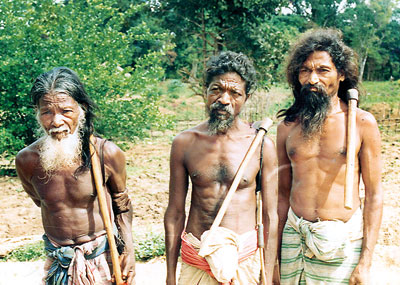Sunday Times 2
Can we break the cycle of cultural extinction in Sri Lanka?
“Apo, you look like a veddah!” is an insult we use when a friend has a bad hair day or to admonish our kids when they look disheveled. In contrast, in our courtrooms and government offices, we claim to respect and mourn the loss of the Veddah culture. We can’t help but view their lifestyles as outdated and their knowledge as limited and, therefore, attempt to resettle and find new professions for this ‘primitive’ community. What can we learn from our attitudes and actions, and how can we relate its effects to the wave of westernisation that is sweeping away our own culture?

Veddah communities have been moved into villages in an attempt made to integrate them into ordinary society
Our actions regarding Veddahs are purported to be altruistic. We have moved their barely surviving communities into villages and attempted to integrate them into ordinary society. But often, the underlying reason is that these communities hinder physical expansion or access to resources of our own towns and villages. The land that is vacated could be then utilised for development projects and the like. We have exploited their ancient practices by making them tourist attractions, converting these otherwise ‘useless’ activities, like making tools and constructing huts, into money-making schemes. We are in awe that Veddahs are ‘wild’ and their existence is dissimilar to our ‘complicated’ lifestyles, so why not use this interest for commercial gain? Thus, their value is assigned to them based on their contribution to the GDP through tourism, and on the quality of leisure time, of the tourists and the rich, spent observing them.
Within their communities however, their worth runs deeper. The Veddahs were the original inhabitants of the country, the true Sri Lankans so to speak. Their population was decimated by the Aryans, who invaded and colonised Sri Lanka circa 500 B.C., whose descendants comprise the majority Sinhala population today. The Veddahs went from a flourishing community inhabiting the whole island, to a far smaller community restricted to the jungles of the Eastern Province. They faced a second blow after independence, when the new indigenous governments decided to open these lands to agriculture. Recently, the little patches of jungle that still remained theirs were declared wildlife sanctuaries, and the last of the Veddahs were forced to leave their traditional homelands. The tiny proportion who still practice a hunter-gatherer lifestyle are keen to continue in this way, and not adapt to a mainstream Sinhala or Tamil way of life. ‘Stop trying to convert us into cultivators and let us be!’ entreated the Veddah patriarch Tissahamy and two tribal leaders.
What relevance does this tragedy have to us? I believe that our actions and attitudes regarding indigenous people are highly reflective of the actions taken by the colonialists during their long reign of over 400 years. Material destruction and economic deprivation aside, the effect of the imperial powers on Sinhala and Tamil culture and lifestyles is so ingrained, it is taken for granted. The businessmen wear suits and shirts to work and on special occasions, while the poor farmer wears the traditional sarong. The fairer girl is chosen to advertise a beauty product over the darker. The man who is fluent in English is addressed as ‘sir’ in conversation by the one who is not. Although these issues seem minor, they demonstrate a different kind of extinction to that of the Veddahs, a loss of pride in national values and an adoption of ‘western’ norms.
The Veddahs were also faced with ‘predatory’ cultures, and burdened with the decimation of most of their population. Yet they persist, even today, in attempting to distinguish themselves from the dominating cultures and refusing to accept the idea that they are lower-class primitives, even when surrounded and greatly outnumbered by the very people who reduced them to this. We, on the other hand, no longer have imperialist rule and did not lose our populations to colonialism, and yet we labour under the most unfortunate belief – that our own culture is second rate and that there is a ‘superior’ culture. It is useless to wait till we are in as severe a situation as the Veddahs are in today to experience a surge of patriotism and pride in our culture. The value of Veddah culture dawned on us only when the possibility of it dying out emerged. We are attempting to revive Veddah populations and culture, thereby righting our wrongs of the past- but we fail to see our own culture deteriorate with no culprit to compensate us for so great a loss.
(The writer is a student at the New York University, Abu Dhabi.)

